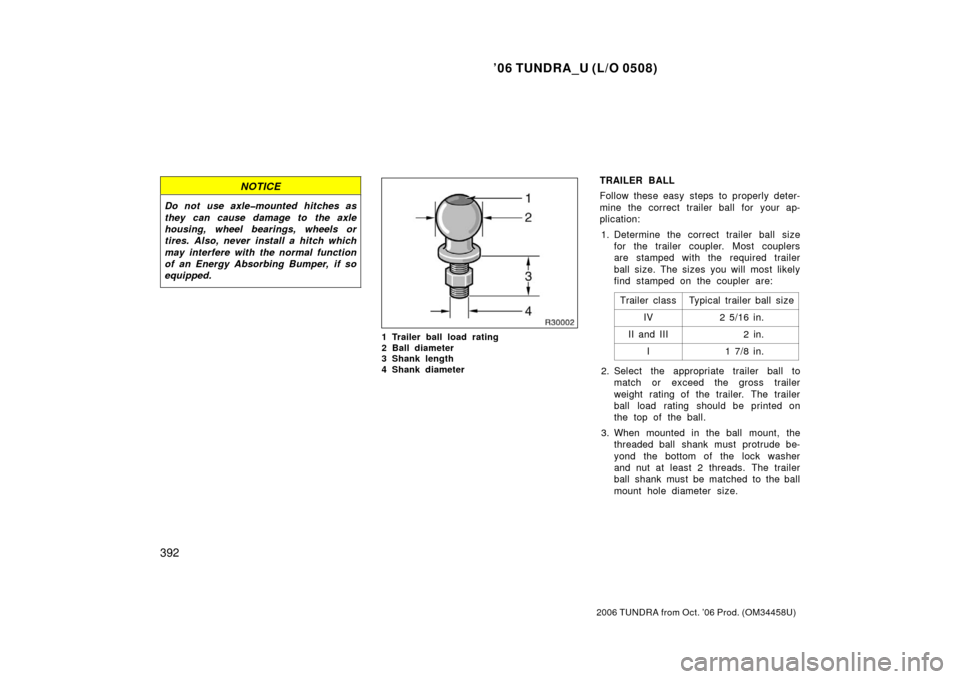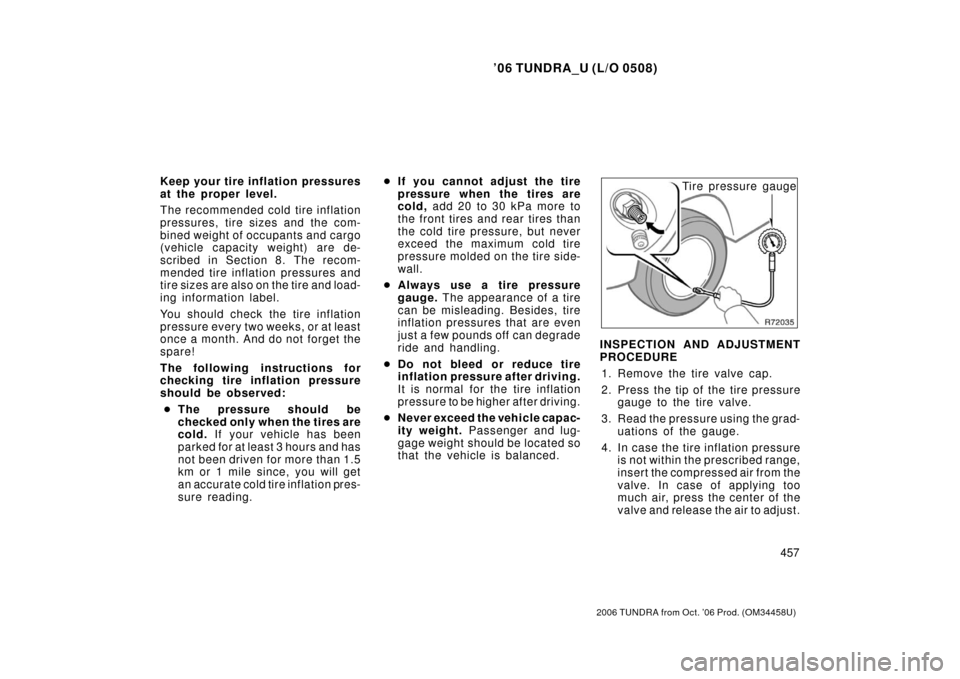Page 380 of 527
’06 TUNDRA_U (L/O 0508)
368
2006 TUNDRA from Oct. ’06 Prod. (OM 34458U)
This illustration indicates typical tire
symbols.
1. Tire size— F or det ails, see “— Ti re
size” in this Section.
2. DOT and Tire Identification Number (TIN)— For details, see
“—DOT and Tire Identification
Number (TIN)” in this Section.
3. Uniform tire quality grading— For details, see “Uniform tire quali-
ty grading” that follows
4. The location of the tread wear indicators— For details, see
“Checking and replacing tires” in
Section 7 −2.
5. Tire ply composition and mate- rials— Plies mean a layer of rub-
ber −coated parallel cords. Cords
mean the strands forming the plies
in the tire.
6. Radial tires or bias�ply tires— A
radial tire has “RADIAL” on the
sidewall. A tire not marked with
“RADIAL” is a bias −ply tir e.
Tire information—
—Tire symbols
Page 381 of 527

’06 TUNDRA_U (L/O 0508)
369
2006 TUNDRA from Oct. ’06 Prod. (OM 34458U)
7. “TUBELESS” or “TUBE
TYPE”— A tubeless tire does not
have a tube inside the tire and air
is directly filled in the tire. A tube
type tire has a tube inside the tire
and the tube maintains the air
pressure.
8. Load limit at maximum cold tire inflation pressure— For details,
see “Checking and replacing tires”
in Section 7 −2.
9. Maximum cold tire inflation pressure— This means the pres-
sure to which a tire may be in-
flated. For details about recom-
mended cold tire inflation
pressure, see “Tires” in Section 8.
10.Summer tire or all season tire— An all season tire has “M+S”
on the sidewall. The tire not
marked with “M+S” is a summer
tire. For details, see “Types of
tires” in this Section.
This illustration indicates typical DOT
and Tire Identification Number (TIN).
1. “DOT” symbol
2. Tire Identification Number (TIN)
3. Tire manufacturer ’s identification mark
4. Tire size code
5. Manufacturer ’s optional tire type code (3 or 4 letters)
6. Manufacturing week
7. Manufacturing year The “DOT” symbol certifies that the
tire conforms to applicable Federal
Motor Vehicle Safety Standards.
—DOT and Tire Identification
Number (TIN)
Page 382 of 527
’06 TUNDRA_U (L/O 0508)
370
2006 TUNDRA from Oct. ’06 Prod. (OM 34458U)
This illustration indicates typical tire
size.
1. Tire use (P=Passenger car, T=Temporary use)
2. Section width (in millimeters)
3. Aspect ratio (tire height to section width)
4. Tire construction code (R=Radial, D=Diagonal)
5. Wheel diameter (in inches)
6. Load index (2 digits or 3 digits)
7. Speed symbol (alphabet with one letter)1. Section width
2. Tire height
3. Wheel diameter1. Bead
2. Sidewall
3. Shoulder
4. Tread
5. Belt
6. Inner liner
7. Reinforcing rubber
8. Carcass
9. Rim lines
10.Bead wires
11. Chafer
—Tire size —Name of each section of tire
Page 386 of 527

’06 TUNDRA_U (L/O 0508)
374
2006 TUNDRA from Oct. ’06 Prod. (OM 34458U)
Ti r e relat ed ter mMeaning
Normal occupant weight68 kg (150 lb.) times the number of occupants specified in the second
column of Table 1 that follows
Occupant distributiondistribution of occupants in a vehicle as specified in the third column of Table
1 that follows
Production options weight
the combined weight of those installed regular production options weighing
over 2.3 kg (5 lb.) in excess of those standard items which they replace,
not previously considered in curb weight or accessory weight, including
heavy duty brakes, ride levelers, roof rack, heavy duty battery, and special
trim
Recommended inflation pressurecold tire inflation pressure recommended by a manufacturer
Rima metal support for a tire or a tire and tube assembly upon which the tire beads
are seated
Rim diameter (Wheel diameter)nominal diameter of the bead seat
Rim size designationrim diameter and width
Rim type designationthe industry of manufacturer ’s designation for a rim by style or code
Rim widt hnominal distance between rim flanges
Vehicle capacity weight
(Total load capacity)the rated cargo and luggage load plus 68 kg (150 lb.) times the vehicle’s desig-
nated seating capacity
Vehicle maximum load on the tirethe load on an individual tire that is determined by distributing to each axle
its share of the maximum loaded vehicle weight and dividing by two
Page 388 of 527

’06 TUNDRA_U (L/O 0508)
376
2006 TUNDRA from Oct. ’06 Prod. (OM 34458U)
Vehicle load limits include total load
capacity, seating capacity, towing ca-
pacity and cargo capacity. Follow the
load limits shown below. Total load ca-
pacity and seating capacity are also
described on the tire and loading in-
formation label. For location of the tire
and loading information label, see
“Checking tire inflat ion pr es s ur e” in
S ec t ion 7 −2.
Total load capacity
(vehicle capacity weight)
Total load capacity means combined
weight of occupants, cargo and lug-
gage. Tongue load is included when
trailer towing. For the total load ca-
pacity about your vehicle, see “Ve-
hicle capacity weight” in Section 8. Seating capacity:
Standard cab modelsTot al 3
Access cab and double cab models
Models with bench type front seats:
Total 6 (Front 3, Rear 3)Models with separate front
seats:
Total 5 (Front 2, Rear 3)
Seating capacity means the maximum
number of occupants whose esti-
mated average weight is 68 kg (150
lb.) per person. Depending on the
weight of each person, the seating ca-
pacity given may exceed the total
load capacity.
NOTICE
Even if the number of occupants
are within the seating capacity,
do not exceed the total load ca-
pacity.
Towing capacity
Towing capacity means the maximum
gross trailer weight (trailer weight plus
its cargo weight) that your vehicle is
able to tow. For the towing capacity
about your vehicle, see “Towing ca-
pacity” in Section 8.
Cargo capacity
Cargo capacity may increase or de-
crease depending on the size (weight)
and the number of occupants. For de-
tails, see “Capacity and distribution”
that follows.
CAUTION
Do not apply the load more than
each load limit. That may cause
not only damage to the tires, but
also deterioration to the steering
ability and braking ability, which
may cause an accident.
Veh icle lo ad limit s
Page 391 of 527

’06 TUNDRA_U (L/O 0508)
379
2006 TUNDRA from Oct. ’06 Prod. (OM 34458U)
Determine what kind of tires your
vehicle is originally equipped with.
1. Summer tires
Summer tires are high −speed capabil-
ity tires best suited to highway driving
under dry conditions.
Since summer tires do not have the
same traction performance as snow
tires, summer tires are inadequate for
driving on snow −covered or icy roads.
For driving on snow −covered or icy
roads, we recommend using snow
tires. If installing snow tires, be sure
to replace all four tires.
2. All season tires
All season tires are designed to pro-
vide better traction in snow and to be
adequate for driving in most winter
conditions, as well as for use all year
round. All season tires, however, do not have
adequate traction performance
compared with snow tires in heavy or
loose snow. Also, all season tires fall
short in acceleration and handling
performance compared with summer
tires in highway driving.
The details about how to distinguish
summer tires from all season tires are
described “—Tire symbols” in Section
2.
CAUTION
�
Do not mix summer and all sea-
son tires on your vehicle as
this can cause dangerous han-
dling characteristics, resulting
in loss of control.
� Do not use tires other than the
manufacturer’s designated
tires, and never mix tires or
wheels of the sizes different
from the originals.
Types of tires
Page 404 of 527

’06 TUNDRA_U (L/O 0508)
392
2006 TUNDRA from Oct. ’06 Prod. (OM 34458U)
NOTICE
Do not use axle�mounted hitches as
they can cause damage to the axle
housing, wheel bearings, wheels or
tires. Also, never install a hitch which
may interfere with the normal function
of an Energy Absorbing Bumper, if so
equipped.
1 Trailer ball load rating
2 Ball diameter
3 Shank length
4 Shank diameter
TRAILER BALL
Follow these easy steps to properly deter-
mine the correct trailer ball for your ap-
plication:
1. Determine the correct trailer ball size for the trailer coupler. Most couplers
are stamped with the required trailer
ball size. The sizes you will most likely
find stamped on the coupler are:
Trailer class
Typical trailer ball size
IV2 5/16 in.
II and III2 in.
I1 7/8 in.
2. Select the appropriate trailer ball to match or exceed the gross trailer
weight rating of the trailer. The trailer
ball load rating should be printed on
the top of the ball.
3. When mounted in the ball mount, the threaded ball shank must protrude be-
yond the bottom of the lock washer
and nut at least 2 threads. The trailer
ball shank must be matched to the ball
mount hole diameter size.
Page 469 of 527

’06 TUNDRA_U (L/O 0508)
457
2006 TUNDRA from Oct. ’06 Prod. (OM 34458U)
Keep your tire inflation pressures
at the proper level.
The recommended cold tire inflation
pressures, tire sizes and the com-
bined weight of occupants and cargo
(vehicle capacity weight) are de-
scribed in Section 8. The recom-
mended tire inflation pressures and
tire sizes are also on the tire and load-
ing information label.
You should check the tire inflation
pressure every two weeks, or at least
once a month. And do not forget the
spare!
The following instructions for
checking tire inflation pressure
should be observed:
� The pressure s hould be
checked only when the tires are
cold. If your vehicle has been
parked for at least 3 hours and has
not been driven for more than 1.5
km or 1 mile since, you will get
an accurate cold tire inflation pres-
sure reading. �
If you cannot adjust the tire
pressure when the tires are
cold, add 20 to 30 kPa more to
the front tires and rear tires than
the cold tire pr essure, but never
exceed the maximum cold tire
pressure molded on the tire side-
wall.
� Always use a tire pressure
gauge. The appearance of a tire
can be misleading. Besides, tire
inflation pressures that are even
just a few pounds off can degrade
ride and handling.
� Do not bleed or reduce tire
inflation pressure after driving.
It is normal for the tire inflation
pressure to be higher after driving.
� Never exceed the vehicle capac-
ity weight. Passenger and lug-
gage weight should be located so
that the vehicle is balanced.Tire pressure gauge
INSPECTION AND ADJUSTMENT
PROCEDURE 1. Remove the tire valve cap.
2. Press the tip of the tire pressure gauge to the tire valve.
3. Read the pressure using the grad- uations of the gauge.
4. In case the tire inflation pressure
is not within the prescribed range,
insert the compressed air from the
valve. In case of applying too
much air, press the center of the
valve and release the air to adjust.